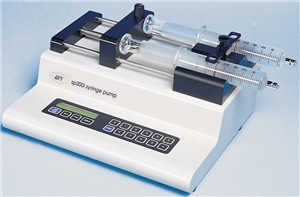
- Overview
- Specifications
- Accessories
- Citations
- Related Products
Overview

There are 1 images available to view - click to enlarge and scroll through the product gallery.
Manual
/ Download as PDF
- Accepts syringe sizes: 10uL - 140mL (two)
- Minimum Flow Rate: 0.001 uL/hr (10µl syringe)
- Maximum Flow Rate: 145 mL/min (140 mL syringe)
- 220-240 V, 50 Hz
Sturdy, reliable, and easy to use
Sturdy and reliable, extremely simple to set up and use - and surprisingly affordable. Liquid crystal displays (LCDs) prompt you through setup: First, select syringe from table stored in the pump's memory and displayed on the LCD. Next, enter the volume to be dispensed. Finally, enter the flow rate, press "start." It's fast and simple. Your settings are permanently stored in memory - there's no need to re-enter them each day. SP pumps feature preset rate and volume control. Just set the volume you want dispensed. Volume is tracked continuously on the LCD display. Then, when the preset volume has been dispensed, the pump shuts off automatically. The easy-to-read digital display provides realtime readings using both parameters and values for clearer, mistake-free readings. The SP200 Series pumps offer TTL and RS-232C interfaces and automatic shutoff under stall conditions.
Features
This feature-laden two-syringe infusion pump combines a broad speed range and holds a wide range of syringe sizes to meet the requirements of virtually any laboratory application. Features include: holds two syringes, 10 to 140 mL, backlit LCD display, knob locks/unlocks drive block for effortless, drag-free adjustment, simple menu-driven setup: Syringe diameter (selected from displayed table), Dispense volume, Dispense flow rate, continuous dispense volume display, preset volume control and automatic shutoff, settings can be reviewed or changed during operation, optical encoder stall detection, choice of unit selection, last settings stored in permanent memory, built-in RS-232C interface for computer linking or "daisy chaining" up to 100 pumps, and TTL interface for foot switch, timer, relay control; outputs for run indicator, valve control.
| Syringe | Diameter | Minimum | Maximum |
|---|---|---|---|
| 10 µl | 0.46 mm | 0.001 µl/hr | 21.1 µl/min |
| 25 µl | 0.73 mm | 0.003 µl/hr | 53.15 µl/min |
| 50 µl | 1.03 mm | 0.005 µl/hr | 105.8 µl/min |
| 100 µl | 1.46 mm | 0.009 µl/hr | 212.6 µl/min |
| 250 µl | 2.3 mm | 0.021 µl/hr | 527.6 µl/min |
| 500 µl | 3.26 mm | 0.042 µl/hr | 1060 µl/min |
| 1 ml | 4.61 mm | 0.083 µl/hr | 2119 µl/min |
| 2.5 ml | 7.28 mm | 0.207 µl/hr | 5286 µl/min |
| 3 ml | 8.59 mm | 0.288 µl/hr | 7360 µl/min |
| 5 ml | 10.3 mm | 0.414 µl/hr | 634 ml/hr |
| 10 ml | 14.57 mm | 0.828 µl/hr | 1270 ml/hr |
| 20 ml | 19.05 mm | 1.414 µl/hr | 2171 ml/hr |
| 30 ml | 21.59 mm | 1.817 µl/hr | 2789 ml/hr |
| 50 ml | 28.9 mm | 3.277 µl/hr | 4998 ml/hr |
| 60 ml | 26.6 mm | 2.757 µl/hr | 4234 ml/hr |
| 100 ml | 34.9 mm | 4.746 µl/hr | 7289 ml/hr |
| 140 ml | 38.4 mm | 5.746 µl/hr | 8824 ml/hr |
Specifications
| Mode | Infusion |
| Syringe Size | 10µL to 140mL (two) |
| Maximum Flow Rate (140 mL syringe | 145 mL/min |
| Minimum Flow Rate | 0.001µL/hr |
| Linear Force | 40 Ib (18 kg) |
| Advance Per Microstep | 0.165 micron |
| Maximum Step Rate | 1600 steps/sec |
| Minimum Step Rate | 1 step/100 sec |
| Accuracy | < 1% error |
| Reproducibility | ± 0.1% |
| Dimensions | 11 x 9 x 5.5 in., 28 x 23 x 14 cm |
| Shipping Weight | 12 Ib (5.4 kg) |
| Notes: | Available 95-135 V or 220-240 V, 50/60 Hz |
Accessories
Citations
Bett, D., & Stevenson, C. (2013). The postsubiculum and spatial learning: the role of postsubicular synaptic activity and synaptic plasticity in hippocampal place cell, object, and object-location. The Journal of …. Retrieved from https://www.jneurosci.org/content/33/16/6928.full
Chiew, K., & Braver, T. (2016). Reward favors the prepared: Incentive and task-informative cues interact to enhance attentional control. Journal of Experimental Psychology: Human …. Retrieved from https://psycnet.apa.org/journals/xhp/42/1/52/
Folbergrová, J., & Ješina, P. (2013). Antioxidant enzymes in cerebral cortex of immature rats following experimentally-induced seizures: upregulation of mitochondrial MnSOD (SOD2). International Journal of …. Retrieved from https://www.sciencedirect.com/science/article/pii/S0736574812006028
Folbergrová, J., Otáhal, J., & Druga, R. (2012). Brain superoxide anion formation in immature rats during seizures: protection by selected compounds. Experimental Neurology. Retrieved from https://www.sciencedirect.com/science/article/pii/S0014488611004134
Ouyang, Z., & Chen, T. (2015). Systems and methods for analyzing a sample. US Patent 9,129,786. Retrieved from https://www.google.com/patents/US9129786
Vu, H., Quinn, R., & Nguyen, N. (2015). Bioaffinity Mass Spectrometry Screening using Droplet-Based Microfluidics. Micro and Nanosystems. Retrieved from https://www.ingentaconnect.com/content/ben/mns/2015/00000007/00000002/art00005
Zhang, Z., Lyon, T., & Kadow, B. (2016). Conduction Block of Mammalian Myelinated Nerve by Local Cooling to 15-30° C after a Brief Heating. Journal of …. Retrieved from https://jn.physiology.org/content/early/2016/01/04/jn.00954.2015.abstract







Request
Catalogue
Chat
Print